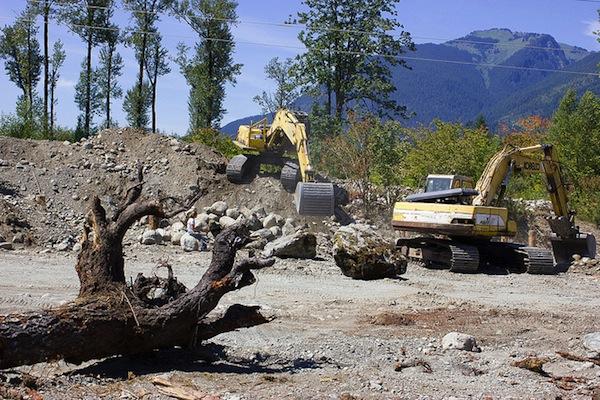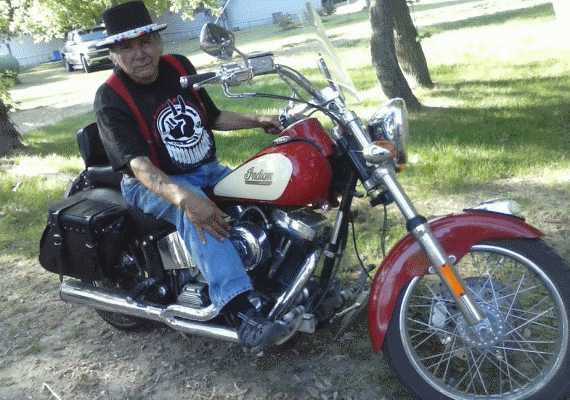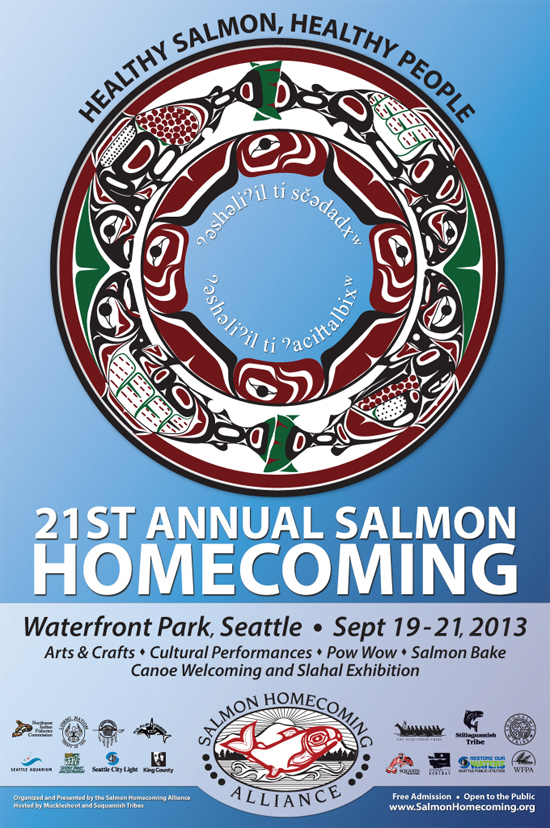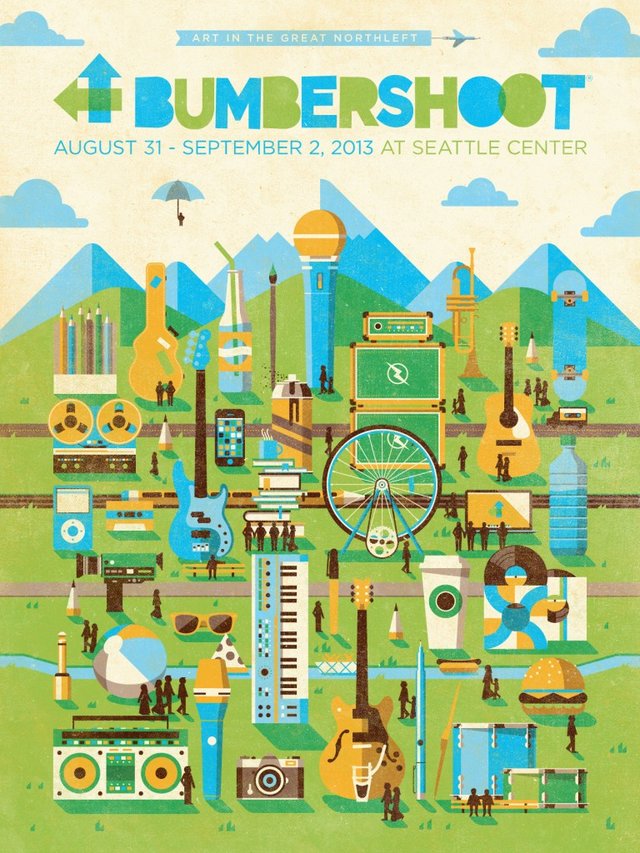
Northwest Indian Fisheries Commission
A dike is removed from Illabot Creek to restore its historic channel, one of several initiatives under way by Northwest tribes to bring back salmon habitat. This effort is by the Swinomish and Sauk-Suiattle tribes under the auspices of the Skagit River System Cooperative.
Richard Walker, Indian Country Today Media Network
As Indigenous Peoples of the Northwest work to restore salmon habitat and with it lost culture and treaty rights, they are grappling with the reality that continued development is undoing their efforts as they go. In September 2012 the Northwest Indian Fisheries Commission released a report, “State of Our Watersheds,” documenting the results of local and state planning that have been in conflict with salmon habitat-recovery goals. Below are the principle findings as to what salmon habitat faces.
RELATED: Northwest Pacific Salmon Habitat Restoration Efforts Hampered by Development
1. Estuaries are losing functional habitat because of population increases in lower portions of watersheds. “In the Suquamish Tribe’s area of concern, there has been a 39 percent loss of vegetated estuarine wetland area and a 23 percent loss of natural shoreline habitats, particularly small ‘pocket’ estuaries,” the report states. “Moreover, there are now 18 miles of bulkheads, fill and docks armoring the shoreline and degrading near-shore salmon habitat.”
All told, some 40 percent of Puget Sound shorelines have some type of shoreline modification, with 27 percent of the shoreline armored.
2. Rapidly increasing permit-exempt wells threaten water for fish. Since 1980, there has been an 81 percent increase in the number of new wells being drilled per 100 new Puget Sound residents moving into the area. The number of exempt wells in the Skagit and Samish watersheds since 1980 has increased by 611 percent, from an estimated 1,080 exempt wells to approximately 7,232.
“When more water is extracted from an aquifer than is being recharged, aquifer volume is reduced and the natural outflow from the aquifer decreases,” the report states. “This reduces the amount of fresh water available to lakes, wetlands, streams and the Puget Sound nearshore, which can harm salmon at all stages of their life cycle.”
3. Degraded nearshore habitat is unable to support forage fish. “In the Port Gamble S’Klallam Tribe’s focus area, according to studies since the 1970s, herring stocks have decreased from a status of healthy to depressed,” the report states. “In Port Gamble and Quilcene bays, which contain two of the largest herring stocks in Puget Sound, approximately 51 percent of spawning areas inventoried by [the] Port Gamble [S’Klallam] Tribe have been either modified or armored.”
4. Timber harvest has removed vast amounts of forest cover throughout all watersheds. In the Stillaguamish watershed, only 23 percent of the 1,777 acres of riparian area currently have any forest cover. In the Snohomish River basin, the Salmon Conservation Plan recommends that 150-foot buffers on both sides of fish-bearing streams be at least 65 percent forested. In 2006, those buffers were just 41 percent forested, with no gain since 1992 and little increase since that time.
5. Streams lack large woody debris. Large woody debris plays an important role in channel stability and habitat diversity. Estimates of large woody debris in the Green and Cedar rivers are 89 to 95 percent below the levels necessary for “properly functioning conditions” for salmon habitat.
6. Barriers cut off vast amounts of fish habitat. Despite extensive restoration efforts, many fish passage barriers, such as culverts, tide gates and levees still block salmon from accessing many stream miles of habitat. In the Quileute management area, culverts fully or partially block more than 168 miles of stream habitat. Most of these culverts are located on private forestlands. Culverts in the Chehalis basin block or impede salmon access to more than 1,500 miles of habitat.
7. Agricultural practices negatively impact floodplains and freshwater wetlands. Diking, draining and removing trees have resulted in a loss of stream buffers, stream channels and wetlands, and resulted in increased sediment and polluted runoff from agricultural activities.
In 1880, the Nooksack basin contained 4,754 acres of wetland to 741 acres of stream channel. By 1938, nearly 4,500 acres (95 percent) of off-channel wetland area had been cleared, drained and converted to agriculture. As of 1998, the lower mainstem retained less than 10 percent of its historical wetlands.
As of 2006, riparian areas of the Skagit River delta region are 83 percent impaired. Of that amount, only 12 percent are developed; the remaining 71 percent of impaired lands support crops and pasture.
8. Sensitive floodplains are being overdeveloped. In the Lower Elwha Tribe’s area of concern, 37 percent of the Morse Creek floodplain has been zoned for development — from utility rights of ways to single-family homes. Downstream of Highway 101, nearly half of the floodplain has also been zoned for similar development.
9. Puget Sound-area impervious surface increased by 35 percent from 1986 to 2006. It is projected that by 2026, the amount of impervious surface will increase another 41 percent.
“The Puget Sound Salmon Recovery Plan (2007) lists ‘Minimize impervious surfaces’ as a key strategy for protecting habitat,” the report states. “Impervious surface causes increases in stream temperatures; decreases in stream biodiversity, as evidenced by reduced numbers of insect and fish species; and contributes to pollutants in storm-water runoff, which can contaminate local aquatic systems.”
10. Loss of forest cover continues. From 1988-2004, Western Washington forestlands have declined by 25 percent—a loss of 936,000 acres of state and private forestland converted to other uses. Recent research from the University of Washington indicates that nearly one million more acres of private forestland are threatened with conversion.
The Skagit River System Cooperative—operated by the governments of the Sauk-Suiattle Tribe and the Swinomish Tribe, in partnership with the Bureau of Indian Affairs, U.S. Forest Service, Northwest Indian Fisheries Commission, Environmental Protection Agency, Pacific Salmon Commission and the state—recommends no new construction of riprap without mitigation. However, since 1998, at least one mile of riprap has been added to the existing 14 miles of riprap shoreline along the middle Skagit River.
“Shoreline armoring contributes to river channel degradation by impeding natural bank erosion and river meandering, and disconnecting terrestrial and aquatic ecosystems, directly impacting salmon habitat,” according to the NWIFC’s report, “State of Our Watersheds.” “Young juvenile chinook have been shown to use river banks modified with riprap at densities five times lower than natural banks.”
Read more at http://indiancountrytodaymedianetwork.com/2013/09/03/state-our-watersheds-top-10-threats-northwest-salmon-habitat-151131
















